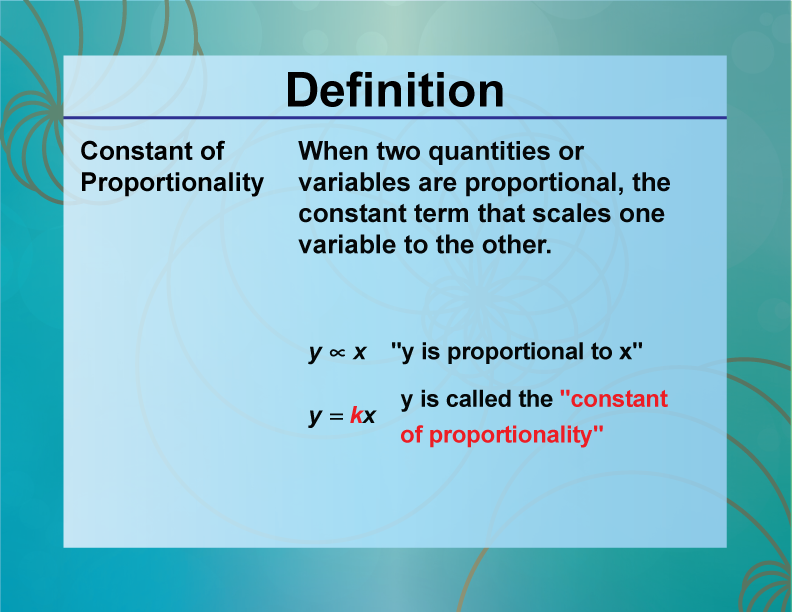
Display Title
Definition--Ratios, Proportions, and Percents Concepts--The Constant of Proportionality
Display Title
Ratios, Proportions, and Percents | Constant of Proportionality
This is part of a collection of definitions on the topic of Rations, Proportions, and Percents. These downloadable images can easily be incorporated into a presentation.
—CLICK PREVIEW TO SEE THE DEFINITION—
To see the complete collection of definitions on this topic, click on this link.
The following section provides additional background on the constant of proportionality, including a video with transcript.
Watch the following video to learn about the constant of proportionality. (The transcript is also included.)
Constant of Proportionality

The video was uploaded on 10/15/2022.
You can view the video here.
The video lasts for 1 minute and 49 seconds.
Video Transcript
When two variables, x and y, are proportional, they are related by way of a constant of proportionality.
There are two ways a constant of proportionality works.
In the first case, as the value of x changes, the value of y changes in a corresponding manner, as you can see in this illustration.
The result is what looks like a straight line of points.
In function notation, the equation y = k*x captures the proportional relationship between x and y.
This type of function is called a direct variation.
The graph of y = kx is a straight line.
The coefficient k is the constant of proportionality.
The constant of proportionality can be positive or negative.
Here's an example of a negative constant of proportionality.
As x increases in value, y decreases in value in a consistent amount.
The graph is still a straight line, but a negative constant of proportionality results in a graph that slants downward, as shown here.
The constant of proportionality is the slope of the line.
The second type of constant of proportionality is called an inverse variation.
In these cases, as x increases in value, y decreases in value.
The equation for an inverse variation looks like this.
Notice the constant of proportionality, k, is the coefficient of the x-term.
The graphs of inverse variations are curves.
Both direct and inverse variations are used to model many real-world phenomena.
Often the constant of proportionality is found through measurement.
To learn more about the constant of proportionality, read the following background material.
Proportions
When two ratios are equal to each other, they can form an equation called a proportion. Look at this definition.
To learn more about proportions, click on this link. It is a presentation that goes over the proportions in more detail.
When proportions include a variable, this results in an equation that can be solved.
To learn more about solving proportions, click on this link. To see worked-out examples of solving proportions, click on this link.
Constant of Proportionality
When two variables x and y are proportional, they are related by way of a constant of proportionality. Look at this definition.
This is part of a collection of definitions related to ratios, proportions, and percents. This includes general definitions for ratios, proportions, percents, as well as terms related to similarity, proportionality, and equivalence of ratios.
Note: The download is a PNG file.
Related Resources
To see additional resources on this topic, click on the Related Resources tab.
Create a Slide Show
Subscribers can use Slide Show Creator to create a slide show from the complete collection of math definitions on this topic. To see the complete collection of definitions, click on this link.
To learn more about Slide Show Creator, click on this Link.
Accessibility
This resources can also be used with a screen reader. Follow these steps.
-
Click on the Accessibility icon on the upper-right part of the screen.

-
From the menu, click on the Screen Reader button. Then close the Accessibility menu.

-
Click on the PREVIEW button on the left and then click on the definition card. The Screen Reader will read the definition.
| Common Core Standards | CCSS.MATH.CONTENT.6.RP.A.1, CCSS.MATH.CONTENT.6.RP.A.2, CCSS.MATH.CONTENT.6.RP.A.3, CCSS.MATH.CONTENT.7.RP.A.3, CCSS.MATH.CONTENT.HSG.SRT.A.1.B, CCSS.MATH.CONTENT.7.RP.A.2.B |
|---|---|
| Grade Range | 6 - 8 |
| Curriculum Nodes |
Algebra • Ratios, Proportions, and Percents • Proportions |
| Copyright Year | 2021 |
| Keywords | ratios, Percent, definitions, glossary terms, rates, proportions, constant of proportionality |